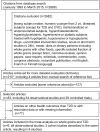Systematic Review and Meta-Analysis of Human Studies to Support a Quantitative Recommendation for Whole Grain Intake in Relation to Type 2 Diabetes
- PMID: 26098118
- PMCID: PMC4476805
- DOI: 10.1371/journal.pone.0131377
Systematic Review and Meta-Analysis of Human Studies to Support a Quantitative Recommendation for Whole Grain Intake in Relation to Type 2 Diabetes
Abstract
Background: Due to the increasing evidence of their health benefits, whole grains are recommended for consumption worldwide. Such recommendations are, however, rarely quantitative. Our aim was to perform a quantitative evaluation of the relationship between whole grain consumption and the occurrence of type 2 diabetes (T2D) to support a recommendation on the daily consumption of whole grains.
Methods and findings: We conducted a systematic review by searching three bibliographic databases. We included human studies addressing the relationship between whole grain consumption and T2D occurrence, and providing quantitative information on daily intake of whole grains. A dose-response meta-regression analysis between whole grain intake and T2D occurrence was performed, using a hierarchical mixed least square linear regression model. Eight observational studies were included (all but one prospective), with a total of 15,573 cases of T2D among 316,051 participants. Quantitative meta-regression demonstrated a significant linear inverse relationship between whole grain intake and T2D occurrence (P<0.0001), with an overall absolute reduction of 0.3% in the T2D rate for each additional 10 g of whole grain ingredient consumed daily. The association persisted when adjusted on sex, age, country, study design, follow up duration, and mode of report of whole grain intakes (as foods or ingredients).
Conclusions: The meta-regression model made it possible to estimate the decrease in T2D risk corresponding to various changes in whole grain intakes, and the results contribute to setting up quantitative recommendations. For instance, consuming three servings of whole grain foods (45 g of whole grain ingredients) daily would induce a 20% relative reduction in the T2D risk as compared to consuming a half serving (7.5 g of whole grain ingredients). These results should be considered for future recommendations, by considering the actual whole grain intake of the concerned populations. The systematic review protocol was published on the PROSPERO register (CRD42013006925).
Conflict of interest statement
Figures


References
-
- Mellen PB, Walsh TF, Herrington DM. Whole grain intake and cardiovascular disease: a meta-analysis. Nutrition, metabolism, and cardiovascular diseases: NMCD. 2008;18(4):283–90. - PubMed
-
- Koh-Banerjee P, Franz M, Sampson L, Liu S, Jacobs DR Jr., Spiegelman D, et al. Changes in whole-grain, bran, and cereal fiber consumption in relation to 8-y weight gain among men. The American journal of clinical nutrition. 2004;80(5):1237–45. - PubMed
-
- Jacobs DR Jr., Andersen LF, Blomhoff R. Whole-grain consumption is associated with a reduced risk of noncardiovascular, noncancer death attributed to inflammatory diseases in the Iowa Women's Health Study. The American journal of clinical nutrition. 2007;85(6):1606–14. - PubMed
Publication types
MeSH terms
LinkOut - more resources
Full Text Sources
Other Literature Sources
Medical

